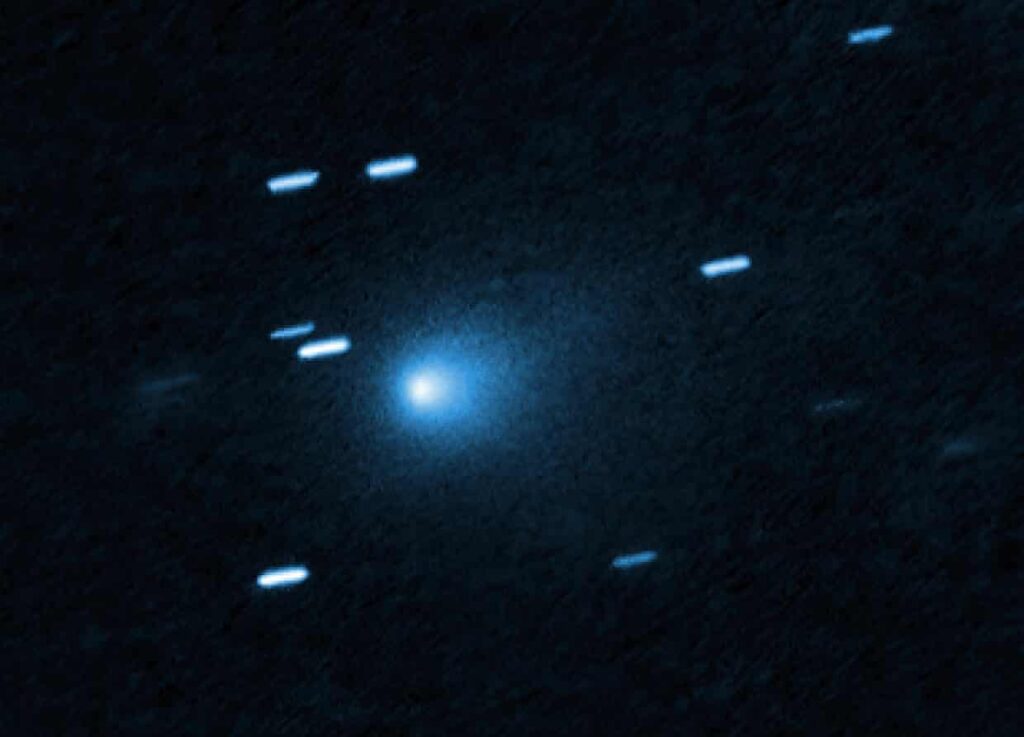
A comet from beyond our solar system, designated as 3I/Atlas, is currently speeding toward the sun at approximately 61 kilometers (38 miles) per second. This remarkable object, first detected in July 2023, is only the third known interstellar object to be observed, following ‘Oumuamua in 2017 and 2I/Borisov in 2019. The excitement surrounding 3I/Atlas has intensified since the Hubble Space Telescope captured its image, providing scientists with a unique opportunity to study its size and chemical composition.
According to Dr. Rebecca Allen, co-director of Swinburne’s Space Technology and Industry Institute, “We’ve never had an object like this to study before.” The origin of 3I/Atlas remains uncertain, but Dr. Laura Driessen, a radio astronomer at the University of Sydney, confirms that it definitely came from outside the solar system. The name itself reflects its interstellar nature, with “i” denoting interstellar, “3” indicating it is the third such object detected, and “Atlas” referring to the network of telescopes that identified it, known as the Asteroid Terrestrial-impact Last Alert System.
While speculation about extraterrestrial origins has surfaced, scientists believe 3I/Atlas is likely a comet rather than an alien spacecraft. “There’s no evidence to point towards [3I/Atlas] being anything other than a really fun space rock that came from outside the solar system,” Driessen stated. “Which, to be honest, is cool enough.”
What Makes 3I/Atlas Special?
The Hubble image reveals 3I/Atlas resembling a “fuzzy snowball,” according to Allen. This appearance results from its coma, a cloud of dust and gas released as the comet’s surface heats up due to solar radiation. As the comet approaches the sun, scientists anticipate that the chemical signatures of elements and molecules from its origin will become more apparent.
Utilizing a technique known as spectroscopy, researchers can analyze the light emitted by the comet to determine its composition. Allen noted, “Does this comet represent a solar system that had very similar conditions to our own, or is it something completely different?” Initial observations suggest that 3I/Atlas has a diameter of less than 5.6 kilometers, with estimates potentially as small as 320 meters.
3I/Atlas is on a hyperbolic trajectory, meaning it is not gravitationally bound to the sun. The comet is expected to cruise through the inner solar system, passing between the orbits of Mars and Earth before making a close approach to the sun. It is anticipated to come within approximately 210 million kilometers of the sun between October and December 2023, after which it will continue its journey back into interstellar space. The closest it will approach Earth is around 270 million kilometers, as reported by NASA.
Observing 3I/Atlas
Currently, 3I/Atlas appears faint, but it is expected to brighten as it nears the sun, eventually becoming visible to large amateur telescopes. Con Stoitsis, comet and meteor director at the Astronomical Society of Victoria, mentioned that while the comet will likely be within reach for amateur astronomers, it may still only appear as a smudge in the sky. “We get bright-ish comets three or four times a year which are visible with small telescopes and binoculars. This is definitely not one of those,” Stoitsis explained. “Unless you’ve got a decent-sized telescope, you won’t see it.”
The ongoing observations of 3I/Atlas not only excite astronomers but also provide invaluable insights into the composition of objects from beyond our solar system. As the comet approaches the sun, scientists will continue to study its properties and gather vital data that may enhance our understanding of the cosmos.







